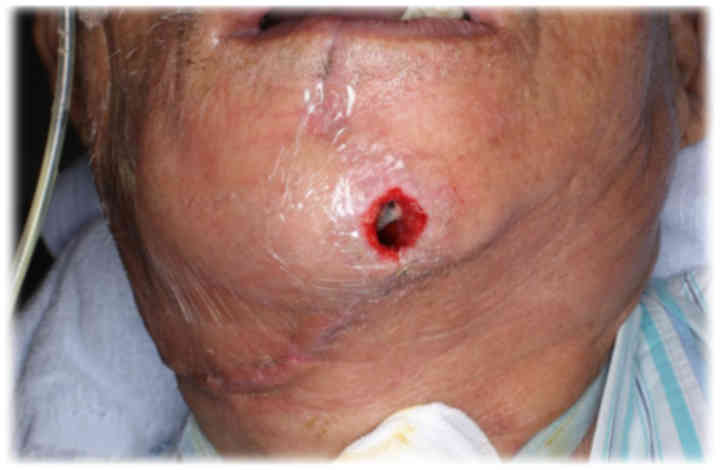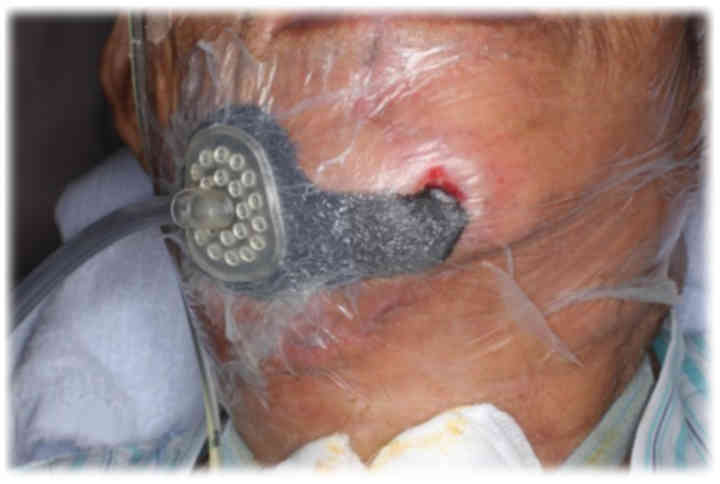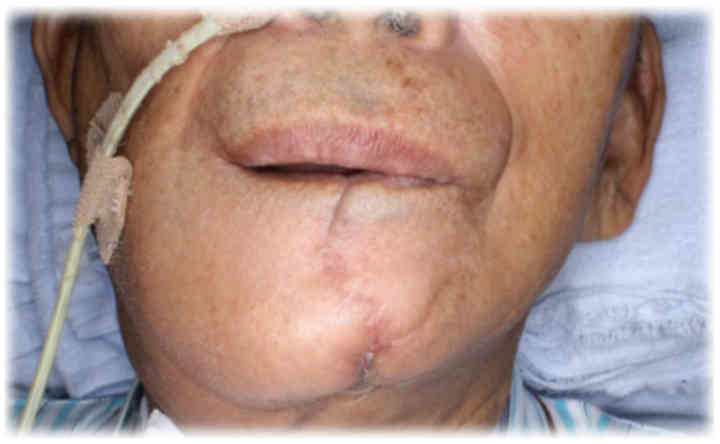Successful management of an orocutaneous fistula and exposed mandibular plate with the vacuum‑assisted closure system: A case report
- Authors:
- Published online on: October 17, 2018 https://doi.org/10.3892/etm.2018.6869
- Pages: 5315-5317
Abstract
Case report
An 84-year-old Japanese man with a T4aN0M0 squamous cell carcinoma of the left lower gingiva underwent left supraomohyoid neck dissection, left-sided segmental mandibulectomy, and pectoralis major myocutaneous flap with a titanium reconstruction plate. On postoperative day 9, dehiscence of the pectoralis major myocutaneous flap from the floor of the mouth to the gingiva was noted. Saliva and pus could be expressed from the chin incision with palpation, and exposure of the titanium reconstruction plate and the presence of an orocutaneous fistula were confirmed (Fig. 1). The patient received antibiotics (flomoxef sodium, 2 g/day), and debridement was performed until healthy, bleeding tissues were reached. On postoperative day 14, the vacuum-assisted closure (VAC) system (VAC Therapy™; KCI Medical, Ltd., Oxfordshire, United Kingdom) was applied to the wound. The wound was sealed with an adhesive drape, which covered the polyurethane foam (V.A.C. GranuFoam™, KCI Medical, Ltd.) and tubing, including 3 cm of the surrounding normal skin to ensure a complete seal. Continuous negative pressure was also applied (100 mmHg; Fig. 2). Subsequently, VAC treatment was repeated every 72 h 7 time in total. Excellent wound healing was achieved, and the orocutaneous fistula was successfully closed without a surgical procedure (Fig. 3). The patient has been followed up for 2 years and 2 months, and there has been no evidence of a recurrent infection.
Discussion
Orocutaneous fistulas tend to occur after extensive resections and are performed for locally advanced tumours of the oral cavity with a reported incidence of 70%. In general, mandibular plate exposure occurs in about 45% of cases, while no standard treatment is performed (1). Particularly in cases of plate infection and exposure, it is necessary to remove the mandibular reconstruction plate to achieve complete recovery. However, there are some disadvantages such as prolonged hospitalization and delayed adjuvant therapy, which can result in a decreased quality of life or vascular rupture. Unfortunately, there is no standardised method of treatment. The management of orocutaneous fistulas is usually determined by their size and location, and the direction of salivary flow (2,3). The VAC system was recently introduced for managing complicated wounds (4), and it is widely used to treat fistulas (5–7). The VAC system has been used on wounds of nearly every aspect of the body but not routinely in the head and neck area such as cancer, trauma and infections. Satteson et al (8), reported the usefulness of VAC system in the treatment of complex head and neck wounds. They reported that wounds healed without complication in 44% of the skin grafts, 67% of Integra-covered wounds, and 71% of debrided wounds. The usefulness of VAC system for orocutaneous fistula have already reported (9–11). Our case report was the first report as a conservative therapy with a postoperative orocutaneous fistula and exposed mandibular plate with only the VAC system. The VAC system also increases the rate of tissue granulation, augments wound contracture and decreases bacterial load on a wound (12). In addition, the VAC system promotes fibroblast stimulation and accelerates removal of excessive fluid from wound (13). In our case, we treated postoperative orocutaneous fistula and exposed mandibular plate with the VAC system. During treatment, the VAC system can save the medical staff time since frequent dressings are unnecessary. Moreover, since VAC is repeated only every 72 h, it facilitates wound care. In our case, there were no complications associated with the VAC system. This is a cost-effective and safe treatment for patients and hospital staff. In fact, there is however some costing research in other patient populations, with one study of patients with diabetic foot wounds finding that the average cost to achieve healing was less in the VAC group (14). We strongly recommend treating orocutaneous fistula with the VAC system in the future.
Acknowledgements
Not applicable.
Funding
No funding was received.
Availability of data and methods
The data generated during the present study are available from the corresponding author on reasonable request.
Authors' contributions
HG, TH and KN made substantial contributions to the design of the VAC therapy, analysis of the clinical data of the work, drafting the manuscript and revising it critically for important intellectual content. All authors gave their final approval of the version to be published and agree to be accountable for all aspects of this work in ensuring that questions related to the accuracy.
Ethics approval and consent to participate
Not applicable.
Patient consent for publication
The patient provided consent for publication.
Competing interests
The authors declare that they have no competing interests.
References
|
EI-Zohairy MA, Mostafa A, Amin A, Abd El-Fattah H and Khalifa S: Mandibular reconstruction using pectoralis major myocutaneous flap and titanium plates after ablative surgery for locally advanced tumors of the oral cavity. J Egypt Natl Canc Inst. 21:299–307. 2009.PubMed/NCBI | |
|
Raman R and Ariayanayagam C: Closure of orocutaneous and pharyngocutaneous fistulas. Plast Reconstr Surg. 79:3101987. View Article : Google Scholar : PubMed/NCBI | |
|
Cohen M, Marschall MA and Greager J III: Early, aggressive management of postoperative oropharyngocutaneous fistulas. Plast Reconstr Surg. 89:56–61. 1992. View Article : Google Scholar : PubMed/NCBI | |
|
Argenta LC and Morykwas MJ: Vacuum-assisted closure: A new method for wound control and treatment: Clinical experience. Ann Plast Surg. 38:563–577. 1997. View Article : Google Scholar : PubMed/NCBI | |
|
Walma MS, Burbach JP, Verheijen PM, Pronk A and van Grevenstein WM: Vacuum-assisted closure therapy for infected perineal wounds after abdominoperineal resection. A retrospective cohort study. Int J Surg. 26:18–24. 2016. View Article : Google Scholar : PubMed/NCBI | |
|
Perentes JY, Abdelnour-Berchtold E, Blatter J, Lovis A, Ris HB, Krueger T and Gonzalez M: Vacuum-assisted closure device for the management of infected postpneumonectomy chest cavities. J Thorac Cardiovasc Surg. 149:745–750. 2015. View Article : Google Scholar : PubMed/NCBI | |
|
Tavusbay C, Genc H, Clin N, Kar H, Kamer E, Atahan K and Haciyanli M: Use of a vacuum-assisted closure system for the management of enteroatmospheric fistulae. Surg Today. 45:1102–1111. 2015. View Article : Google Scholar : PubMed/NCBI | |
|
Satteson ES, Crantford JC, Wood J and David LR: Outcomes of vacuum-assisted therapy in the treatment of head and neck wounds. J Craniofac Surg. 26:e599–e602. 2015. View Article : Google Scholar : PubMed/NCBI | |
|
Andrews BT, Smith RB, Hoffman HT and Funk GF: Orocutaneous and pharyngocutaneous fistula closure using a vacuum-assisted closure system. Ann Otol Rhinol Laryngol. 117:298–302. 2008. View Article : Google Scholar : PubMed/NCBI | |
|
Tian B, Khoo D, Tay AC, Soo KC, Tan NC, Tan HK and Iyer NG: Management of orocutaneous fistulas using a vacuum-assisted closure system. Head Neck. 36:873–881. 2014. View Article : Google Scholar : PubMed/NCBI | |
|
Tian B, Iyer NG, Tan HK, Tay AC, Soo KC and Tan NC: Novel technique of creating a seal for the vacuum-assisted closure system application in complex head and neck wounds. Head Neck. 38:E2523–E2526. 2016. View Article : Google Scholar : PubMed/NCBI | |
|
Morykwas MJ, Argenta LC, Shelton-Brown EI and McGuirt W: Vacuum-assisted closure: A new method for wound control and treatment: Animal studies and basic foundation. Ann Plast Surg. 38:553–562. 1997. View Article : Google Scholar : PubMed/NCBI | |
|
Venturi ML, Attinger CE, Mesbahi AN, Hess CL and Graw KS: Mechanisms and clinical applications of the vacuum-assisted closure (VAC) Device: A review. Am J Clin Dermatol. 6:185–194. 2005. View Article : Google Scholar : PubMed/NCBI | |
|
Apelqvist J, Armstrong DG, Lavery LA and Boulton AJ: Resource utilization and economic costs of care based on a randomized trial of vacuum-assisted closure therapy in the treatment of diabetic foot wound. Am J Surg. 195:782–788. 2008. View Article : Google Scholar : PubMed/NCBI |












